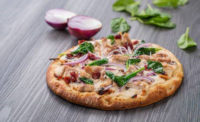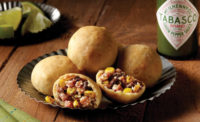Who doesn’t enjoy a sweet treat from time to time? In fact, when surveyed by Datassential last year, 93 percent of consumers had eaten dessert in the past week, and 55 percent had enjoyed dessert within the past day (Datassential, “Dessert’s Sweet Spot,” Keynote Report, 2019). And with consumers required to stay at home due to the global pandemic, demand for in-home desserts was expected to increase.
Consumers are seeking comfort in the foods they eat. However, health and wellness and specialized diets aren’t completely out of the picture. This is resulting in the growth of free-from options, such as gluten-free and dairy-free, and plant-based options in top dessert categories.
Overview | Bread | Tortillas | Sweet Goods | Snack Cakes | Pizza | Desserts | Cookies | Buns & Rolls | Bars | Breakfast Products
Market data
Coming off a year of decline, the majority of the dessert segments experienced growth this year. The pies and cakes category saw a 1.9 percent increase in sales to $1.9 billion, based on the latest 52-week period ending April 19, 2020, per IRI, Chicago.
The cake segment was the main contributor to the growth, up 2.4 percent to $1.5 billion. The majority of the companies in the segment demonstrated growth. Private label leads cakes by a large margin and grew 1.5 percent to $918.2 million. The No. 2 company in cakes, Grupo Bimbo, increased sales by 2.7 percent to $126.7 million. Additional bright spots in the category were:
- CMS Bakery Products grew 13.1 percent to $42.3 million
- Rich Products Corp. grew 16.5 percent to $24.5 million
- Bundt cake specialist Hometown Foods grew an impressive 124.0 percent to $18.9 million
The pie category was flat for the year, up 0.1 percent with sales remaining at $427.3 million. Similar to the cake category, private label accounts for a strong percentage of the category. However, private label pie sales declined 3.6 percent, dropping to $287.8 million. Positive growth from several companies offset some of the decline. Jesse Lord Bakery grew 4.8 percent to $33.0 million, and Table Talk Pies experienced double digit growth of 29.8 percent to $28.0 million
The frozen pies segment rebounded from a decline the prior year, with 5.7 percent growth leading to $524.8 million in sales. Schwan Co. brand Edwards Pies grew 7.6 percent to $218.7 million, contributing to the bulk of growth for the company in the segment. Marie Callender’s from Conagra Brands grew 11.4 percent to $180.9 million.
The refrigerated cheesecake category continued an upward sales trajectory with a third straight year of positive sales performance. The category grew 6.7 percent to $341.6 million. Private label leads the way again in this category and increased 11.1 percent to $206.3 million. The top brand in the category, The Father’s Table, saw double-digit growth of 13.6 percent to $69.8 million.
Looking back
The dessert category has responded to consumer demand for healthier food choices, which has resulted in the creation of a variety of new products to address specific dietary needs, such as gluten-free, plant-based, dairy-free, and/or clean label.
Almonds are versatile ingredients that go into both traditional and gluten-free formulations. “Almond flour can be a wonderful solution in gluten-free formulas,” says Priscilla Martel, chef, industry food consultant, and almond ambassador, New York. “With almond flour, you’re dealing with a gluten-free ingredient with a smooth texture, so it’s not gritty like some of the starchier wheat flour alternatives. It can bind water, even though it doesn’t have the protein content of wheat flour, and also has an advantage because so many gluten-free flour blends are often high in starch from soy or corn. Almond flour is an all-natural, ‘free-from’ ingredient, and it has the delicious flavor of almonds.” She notes that she has had great success using almond flour in egg-foam preparations, like chiffon cake and carrot cake, by swapping out all the wheat flour.
“Keto diets, sugar-free options, gluten-free, and dairy-free were big in 2019,” says Jasmine Weiser, head chef, Edwards Dessert Kitchen, Schwan Co., Marshall, MN. “Sustainability and natural ingredients with an air of healthy living became something for the everyday consumer.” She also notes that major flavor profiles in 2019 included banana, tahini, rose water, hibiscus, and other floral flavors.
“Round and sheet cakes remain very popular,” says Andy Sigrist, consultant, Unifiller Systems, Delta, British Columbia. “Some recent trends on round layer cakes are being taller, with up to six layers. Where sheet cakes used to be typically single layer, recent trends are toward two-layer sheet cakes. Cheesecakes, pies and bar cake trends remain strong.” He also notes that dietary trends, such as gluten-free, continue to gain market share.
Desserts are also shifting to an anytime indulgence as consumers look to treat themselves whenever they want. The Eli’s Cheesecake Co., Chicago, notes small indulgences and portion size continues to be an important trend in 2020, and snackable desserts offer retailers a convenient way to serve dessert while minimizing waste. “We also continue to see growth in the plant-based area,” says Debbie Marchok, vice president of marketing. “Whether you lead a vegan lifestyle or define yourself as flexitarian, minimizing your intake of dairy and eating plant-based is on the rise.
Eli’s offers a single-serve and 7-inch Belgian Chocolate Vegan Cheesecake, as well as the new Dairy-Free Vegan Lemon Raspberry Cheesecake. Both are made with non-GMO tofu, sourced locally from Chicago’s Phoenix Bean. The Vegan Lemon Raspberry Cheesecake is baked on a layer of lemon cake, finished with raspberry gelée and a dusting of raspberry powder.
“Our vegan products are certified by Vegan Action. No longer a niche item, plant-based foods are now part of daily life and here to stay,” states Marchok.
According to Dataessential, savory flavors are increasingly appearing on restaurant dessert menus. Eli’s recently launched a Goat Cheese Cheesecake to address this sweet and savory trend. “Our tangy, rich, and not-too-sweet cheesecake is made from creamy goat cheese and cultured cream cheese, baked on a vanilla crumb crust, topped with goat cheese crumbles, and sweetened with honey produced by student beekeepers at the Chicago High School for Agricultural Sciences,” says Marchok. “The result is a more-savory dessert that has an extremely unique mix of cultured notes from the combo of goat cheese and cream cheese.”
Eli’s new Basque Cheesecake has a “familiar with a twist” approach. “Eli Schulman created Chicago-style cheesecake 40 years ago by breaking all the rules: no water bath, and baking hot and fast. His golden-brown, caramelized top acted as a heat shield, allowing the rich custard below to soufflé.” Fast-forward to today and Eli’s is using the same technique to make Basque Cheesecake, a trending dessert from Spain. “It’s a little darker on top than Eli's original,” says Marchok, “and the inside reveals such a rich, creamy texture.”
Another new product from Eli’s is its Deep Dish Cherry Cheesecake. “Our newest novelty dessert is a Deep-Dish Cherry ‘Pizza’ Cheesecake, which looks like its famous Chicago-style deep dish pizza counterpart,” says Marchok. Eli’s Original Plain Cheesecake is the “mozzarella cheese” layer, cherry topping is the “tomato sauce,” and grated white chocolate is the “Parmesan cheese” on top.
Desserts need to deliver a multi-sensory experience of taste and texture. Vream Elite specialty shortenings from Bunge Loders Croklaan, Chesterfield, MO, deliver the sensory experience consumers expect and also provide functional benefits. “These premium shortenings maximize the taste, texture, and functionality of icings, cakes, and pies,” says Mark Stavro, senior director of marketing. “Vream Elite is made by using enzymes to blend high-stability, soybean oil and soy hard fat. It enables bakers to create bright-white icings, high-volume cakes, and flaky pie crusts. Vream Elite is also very easy to use, as it has great workability across a wide range of temperatures, shows exceptional creaming with all types of ingredients and avoids post-hardening.”
Looking forward
Consumers are looking for exciting textures and flavors, according to Innova Market Insights data shared by the Almond Board of California, Modesto, CA. “Looking ahead, desserts will benefit from incorporating ingredients that stimulate the senses and offer new experiences,” says Harbinder Maan, associate director of trade marketing and stewardship. “‘Crunchy’ is the top texture claim among almond bakery, making almonds an appealing inclusion for desserts. However, almonds come in a range of forms also suited to creamy, smooth, or crispy experiences. Almond butters and flours can also provide the perfect base, blending beautifully in dessert products to help any flavor shine.” She notes that almonds can be roasted to kick indulgence up a notch, deepening any dessert’s nutty flavor profile or imparting crunchier and crispier textures.
“The biggest food trend I have seen growing in 2020 so far is the desire for more plant-based foods and plant proteins,” says Weiser. “While this may not be exclusive to the dessert sector, I think that the consumer will be looking for those vegan and dairy-free desserts that still taste amazing. Customization and uniqueness is also growing as younger people are more apt to try something interesting or that they have not had before. You may also see more cross-cultural seasoning, like Tajín or togarashi spices in desserts to tie in the exotic and uniqueness people will be looking for.”
In light of the recent pandemic, safety will remain top-of-mind, and tamper-proof, prepackaged desserts will continue to be important. Consumers are seeking comfort—and assurance of safety.
According to Unifiller, the main trends for the coming year will focus on processes and efficiencies as manufacturers, specifically bakeries, consider the impact related to the COVID-19 pandemic.
“Automating has already been a trend in the industry,” says Sigrist. “Bakeries will continue to shift pre-bake and post-bake processes to be more automated.” This reduces reliance on staff, significantly improves accuracy of portion control, and reduces product waste, helping improve cost control. “Unifiller Systems is ready and capable to meet the demands of the current industry trends and unique situation in the world,” he says. “Bakeries are making capital decisions, from single-piston depositors to automation systems that are easy to set up, operate, clean and maintain. Bakeries are demanding flexible, modular automation systems that can be easily configured to produce a variety of products.”
One industry trend where Unifiller Systems is offering solutions relates to collaborative robotic (cobot) solutions. “Cobots are very good and consistent at repetitive tasks,” says Sigrist. “They are affordable and unique where they are intended to interact with bakery staff in a shared space to work safely. Unifiller Systems is offering and implementing primarily solutions for post-bake processes such as decorating cakes and pies, as well as pre-bake for handling pans.”
Overview | Bread | Tortillas | Sweet Goods | Snack Cakes | Pizza | Desserts | Cookies | Buns & Rolls | Bars | Breakfast Products










